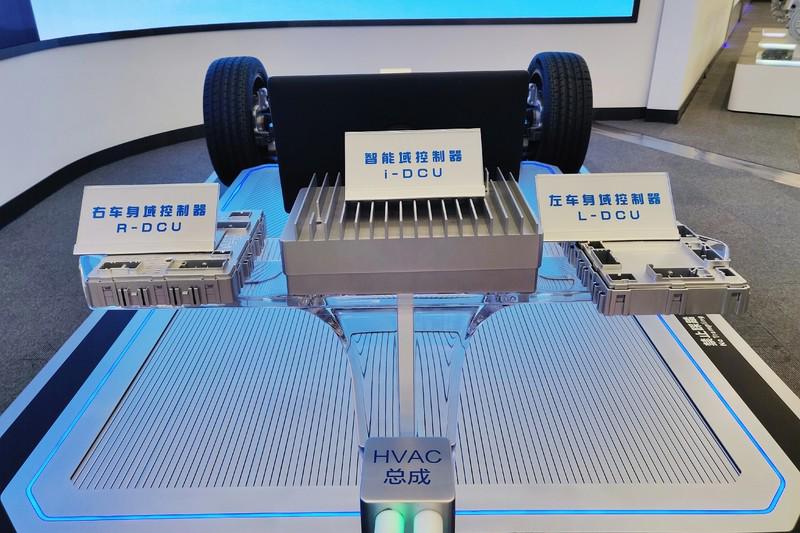BYD Atto3 and e-platform 3.0: Intelligent, Efficient, Safe
 Kevin WongFeb 23, 2024, 07:25 PM
Kevin WongFeb 23, 2024, 07:25 PM
The BYD Atto3 is already a global model, with a presence in regions such as Europe, Australia, and South America, including Thailand. In 2023, the Atto3 was the best-selling pure electric vehicle in Thailand, with sales approaching 20,000 units for the year.
However, many people may not be familiar with this car or BYD, the strong new energy vehicle brand from China. Technology is actually one of the key highlights of the Atto3, but what exactly is the e-platform 3.0 and technologies like blade batteries? What changes can it bring to practical use?
In this article, we'll discuss the technology related to BYD's e-platform 3.0. Although this platform was released in 2021, even today, BYD's main models are still based on the e-platform 3.0, whether they are sold in China or exported to overseas markets, such as the Atto3.
Here are a few points about the benefits of vehicle platformization that we need to know:
1. Cost reduction: Different models on the same platform can share many components, reducing component production costs and the selling price of the entire vehicle.
2. Stable quality: Parts sharing improves the stability of components' quality.
3. Shortened development cycle: This is an important advantage for automakers. The platform acts as a base model with a fixed structure and variable parts, allowing different models to be adjusted in the variable parts.
4. Improved vehicle dynamics: Platform development can ensure the vehicle's dynamic performance from the beginning, such as improving body rigidity for better handling or emphasizing comfort. An example of this is Toyota's TNGA architecture.
Regarding the e-platform 3.0, here are some key points:
1. e-platform 3.0 comes standard with blade batteries.
2. Integration of the body and battery.
3. A new domain-controlled electrical architecture.
4. Independently developed BYD OS operating system.
5. Innovative eight-in-one electric drive assembly, with a comprehensive efficiency exceeding 89%.
6. Wide-temperature, high-efficiency heat pump system, improving winter range by up to 20%.
7. 800V high-voltage fast charging, providing a range of 150km in 5 minutes.
8. Range exceeding 1000km, with the fastest acceleration of 2.9s per 100km.
BYD's e-platform 3.0 is officially touted for its intelligence, efficiency, and safety. Let's look at each aspect separately.
1. Intelligence:
Four major domain controllers
e-platform 3.0 fundamentally designs the vehicle's electrical architecture in a modular and centralized manner. The biggest highlight is integrating dozens of ECUs into four major domain controllers (left vehicle body domain controller, right vehicle body domain controller, intelligent domain controller, power domain controller).
In simple terms, it transforms from a single-function single-ECU to a multi-core CPU domain controller with stronger processing capabilities, and through CPU integration, the computing power of e-platform 3.0 has increased by 30%; through function integration, the interaction efficiency of controllers has increased by 50%, laying a solid foundation for powerful advanced driving assistance systems in the future.
Independently developed BYD OS vehicle system
This system is not as simple as modifying the Android system. Its main function is to decouple the hardware layer from the application layer, that is, the software and hardware are independent of each other, achieving a higher level of synergy and better utilization of the vehicle's advanced electrical architecture.
A self-developed vehicle system can more efficiently achieve high-level autonomous driving, greatly improving the iteration speed of new functions. Therefore, the iteration speed of new functions of e-platform 3.0 has become faster, from the current two-month iteration cycle to two weeks, reducing by more than 70%.
Lidar
In the field of intelligent driving, BYD will use lidar + cameras + millimeter-wave radar intelligent driving hardware, which means that the existing e-platform 3.0 will also have strong expansion capabilities in future intelligent functions.

2. Efficiency
Eight-in-one electric drive assembly
The three-in-one electric drive system composed of a drive motor, motor controller, and reducer is a technological highlight we often hear about in many new energy vehicles. In e-platform 2.0, BYD proposed an easy-to-understand "33111" concept, which means a three-in-one drive motor, a three-in-one high-voltage controller, a multiple-in-one low-voltage controller, one power battery, and one DiLink intelligent networked central control screen. Just the three-in-one drive motor and the three-in-one high-voltage controller can reduce the weight of the entire vehicle by 40% and save 37L of space.
In e-platform 3.0, BYD directly integrated an eight-in-one electric drive assembly, which includes the drive motor, motor controller, reducer, onboard charger, DC converter, distribution box, vehicle control unit, and battery manager.

Why make an eight-in-one electric drive assembly? Highly integrated electric drive assemblies can better achieve lightweight and miniaturization, not only reducing the space occupied by the electric drive assembly and freeing up more space for the cabin or suspension system but also achieving more efficient power transmission. This eight-in-one electric drive assembly has a comprehensive efficiency exceeding 89%, effectively reducing the loss of power transmission and bringing better economy.
In terms of parameters, the front-drive eight-in-one electric drive assembly of e-platform 3.0 has a peak power of 150kW and a peak torque of 310N·m; the rear-drive eight-in-one electric drive assembly has a peak power of 270kW and a peak torque of 360Nm.
High-performance silicon film-driven motor
The drive motor of e-platform 3.0 adopts a hairpin-style flat wire motor, with a 15% increase in slot filling rate and an optimized magnetic circuit design using ultra-thin high-performance silicon films. After operation, the rated power of the entire drive motor is increased by 40%, and the motor's maximum efficiency can reach 97.5%.

SiC electronic control
With a more efficient drive motor, it naturally needs to be matched with a higher-performance electronic control system. e-platform 3.0 uses a new generation of SiC electronic control. This electronic control system uses a self-developed 1200V/840A new SIC module (maximum voltage 1200V, maximum current 840A) and is equipped with high-performance silicon nitride ceramics and integrated NTC sensors. The entire electronic control system's power density is nearly tripled, and the electronic control's maximum efficiency reaches 99.7%.
Range of 150km in 5 minutes of charging
In e-platform 2.0, BYD used an independent boost charging device to increase the output voltage of the charging pile to achieve a stable fast charging mode. e-platform 3.0 adopts a new motor boost charging architecture, equipped with the world's first motor-driven boost charging technology, integrating driving and charging deeply to achieve 800V high-voltage fast charging.
Range exceeding 1000km?
BYD's future vehicles equipped with blade batteries (lithium iron phosphate batteries) will exceed 1000km in range.

In addition to using larger capacity battery packs, increasing range can also be achieved through improved drive efficiency, optimized electronic control system logic, lightweighting, and reducing aerodynamic drag. The drive system's efficiency has already been mentioned, so it won't be repeated here, but the new vehicles on e-platform 3.0 can achieve a minimum drag coefficient of 0.21Cd, which can naturally improve range.
Of course, increasing the energy density of the battery can also improve the range. Compared with ternary lithium batteries, lithium iron phosphate batteries have a lower battery energy density. BYD is expected to achieve a breakthrough in the energy density of lithium iron phosphate batteries to exceed 1000km in range.
3. Safety
Standard blade batteries
The new cars built on the e-platform 3.0 will all be equipped with blade batteries (lithium iron phosphate batteries), which is not really a highlight because as early as April 2021, BYD's electric vehicles had already been fully equipped with blade batteries. One of the highlights of blade batteries is safety. When BYD introduced blade batteries to the Chinese market, it conducted a series of comparative experiments on puncture of battery packs, which caused a heated topic in China and became one of the core technologies of BYD's models.

Integration of body and battery
Blade batteries themselves have a flat design, which is close to the body floor. Therefore, on the e-platform 3.0, BYD integrates blade batteries into the body, directly making the body and battery integrated, making the battery pack part of the body structure, thereby improving the overall strength of the vehicle.
Under the new platform, the body's torsional stiffness can reach 40,000Nm, which can effectively suppress chassis vibration, improve driving feel and handling performance, and greatly improve the vehicle's safety performance.
In addition, the body structure has been adjusted for pure electric vehicles, such as further reducing the height difference of the longitudinal beams, making the transfer of impact forces smoother during frontal collisions, and improving the dispersion and absorption of impact forces. The application of a full-frame subframe can also improve the body's strength and make the force transmission path more uniform.
Editor's comment
It should be noted that it has been more than two years since the e-platform 3.0 was released. Some technical parameters in this article may have changed with the improvement of component performance during this period, but its overall characteristics have not fundamentally changed.
BYD's new energy vehicles are not only selling well in China but also in the global new energy vehicle market, indicating that BYD has deep technological capabilities in the field of new energy vehicles. It is understood that when BYD was founded in the 1990s, it started with battery manufacturing and later expanded into various fields. Entering the automotive field was something that happened twenty years ago. But since then, BYD has been making new energy vehicles, which is also a unique feature of the BYD brand.
Today, BYD's models such as Atto3, Dolphin, and Seal are available for sale in China, but it is evident that Atto3 is more popular. How will BYD develop its presence in the Thai market in the future? We will wait and see!
If any infringement occurs, please contact us for deletion

Toyota Tundra Owner Achieves the Second Million-Mile Milestone
[PCauto] The mileage often measures the quality and durability of a car, and Victor Sheppard and his two Toyota Tundra pickups have set a staggering record.With Victor Sheppard's dedication and careful maintenance of the Toyota Tundra, he successfully drove two different Tundra pickups over 1 million miles (approximately 1,609,340 kilometers).In 2007, Sheppard bought a brand new Toyota Tundra CrewMax. Over the next nine years, as a contractor, he worked across the United States, from Louisiana t

BYD Plans to Promote 1000V High Voltage Super Charging Stations and Its Models on a Large Scale
【PCauto】Recently, the news that BYD plans to massively implement a 1000V high-voltage supercharging platform has attracted widespread attention. It is reported that this platform will be launched in the middle of March this year and supports super-fast charging above 5C. After its release, it will quickly be popularized to its own models and large-scale construction of 1000V supercharging stations.This move will undoubtedly set off a wave in the new energy vehicle market. Let's delve into the te

XPENG G9 is about to be launched in China, bringing 66 upgrades in features
【PCauto】XPENG has recently announced that the 2025 XPENG G9 will soon be launched in China. Although the official did not announce the time and price, the success of XPENG G6 and X9 has rekindled expectations for the once-failed G9 by XPENG. In terms of appearance, the G9 continues the X-BOT FACE 3.0 design language, with a closed grill at the front paired with split-style headlights on both sides, new two-tone collision colors and all-black body styles, with a petal-style wheel hub. Combining

BYD YANGWANG U7 Launches with World's First Suspension Charging Tech
[PCauto] On March 27, BYD YANGWANG U7 was launched, with two power versions of pure electric and plug-in hybrid, a total of four models. YANGWANG U7 EV Five-seater Luxury Edition, priced at about 292.85 million baht/RM38.31 YANGWANG U7 EV Four-seater Flagship Edition, priced at about 330.04 million baht/RM43.19 YANGWANG U7 PHEV Five-seater Luxury Edition, priced at about 292.85 million baht/RM38.31 YANGWANG U7 PHEV Four-seater Flagship Edition, priced at about 330.04 million bah

What will the new Perodua Car look like in 2025? What kind of changes will they undergo?
【PCauto】In 2025, Perodua will introduce a series of anticipated new car dynamics, covering the launch of new models and remodeling of several existing models, whether in the bold step in the field of electrification or in the optimization of classical models.Perodua is to launch its first electric car in 2025Perodua's first pure electric car is expected to go on sale officially in the fourth quarter of 2025. To ensure the vehicle's performance and quality, Perodua may initiate testing work as ea
Popular Cars
Car Compare



